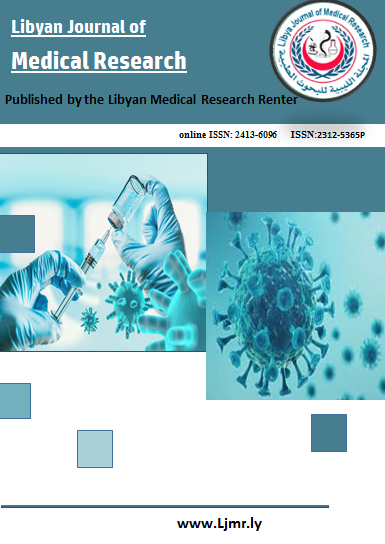Effectiveness of Advanced Pediatric Life Support Training in Enhancing Knowledge among Fifth-Year Medical Students -Faculty of Medicine -University of Tripoli
DOI:
https://doi.org/10.54361/LJMR.19.1.24Keywords:
effectiveness, advanced Pediatric Life Support, knowledge, fifth-year medical student, Faculty of MedicineAbstract
Background: Advanced Pediatric Life Support (APLS) training is essential for preparing medical students to manage pediatric emergencies effectively. Aim: This study aimed to assess the effectiveness of APLS training in enhancing the knowledge of fifth-year medical students at the Faculty of Medicine, University of Tripoli. Methods: Quasi-experimental using a pre-post- intervention was conducted from 10th December 2023 to 8th February 2024, at the pediatric skill lab, faculty of medicine University of Tripoli. Pre-and post-training assessments were conducted to evaluate students' knowledge of pediatric emergency management. SPSS 27 package program was used for statistical analysis. Results: A total of 186 medical students rolled in the study, 76% were females, and 24% were male, the overall pretraining knowledge scale of the students ranged from 51% to 70%, with a mean of 2.7± 0.6 and the overall post-training knowledge scale improved from 71% to 85%, with a mean 4 ±0.8. p-value <.001. Significant improvements were observed across various domains, including airway management, medication administration, and post-resuscitation considerations (p-value <0.05). Conclusion: APLS training significantly enhances the short-term knowledge of fifth-year medical students in managing pediatric emergencies. We recommend Continuous evaluation of APLS training, comparative studies on teaching modalities, and research into long-term knowledge retention to enhance pediatric emergency care education
Downloads
References
1. J. López-Herce, J. Del Castillo, M. Matamoros, S. Cañadas, A. Rodriguez-Calvo, C. Cecchetti, et al. Factors associated with mortality in pediatric in-hospital cardiac arrest: a prospective multicenter multinational observational study.Intensive Care Med, 39 (2013), pp. 309-318 http://dx.doi.org/10.1007/s00134-012-2709-7 | Medline
2. F.W. Moler, K. Meert, A.E. Donaldson, V. Nadkarni, R.J. Brilli, H.J. Dalton, et al. In-hospital versus out-of-hospital pediatric cardiac arrest: a multicenter cohort study.Crit Care Med, 37 (2009), pp. 2259-2267http://dx.doi.org/10.1097/CCM.0b013e3181a00a6a | Medline
3. Holmberg MJ, Ross CE, Fitzmaurice GM, Chan PS, Duval-Arnould J, Grossestreuer AV, Yankama T, Donnino MW, Andersen LW; American Heart Association’s Get With The Guidelines–Resuscitation Investigators. Annual Incidence of Adult and Pediatric In-Hospital Cardiac Arrest in the United States.Circ Cardiovasc Qual Outcomes. 2019; 12:e005580. LinkGoogle Scholar
4. Atkins DL, Everson-Stewart S, Sears GK, Daya M, Osmond MH, Warden CR, Berg RA; Resuscitation Outcomes Consortium Investigators. Epidemiology and outcomes from out-of-hospital cardiac arrest in children: the Resuscitation Outcomes Consortium Epistry-Cardiac Arrest.Circulation. 2009; 119:1484–1491. doi: 10.1161/CIRCULATIONAHA. 108.802678 LinkGoogle Scholar
5. Knudson JD, Neish SR, Cabrera AG, Lowry AW, Shamszad P, Morales DL, Graves DE, Williams EA, Rossano JW. Prevalence and outcomes of pediatric in-hospital cardiopulmonary resuscitation in the United States: an analysis of the Kids’ Inpatient Database*.Crit Care Med. 2012; 40:2940–2944. doi: 10.1097/CCM.0b013e31825feb3fCrossrefMedlineGoogle Scholar
6. Virani SS, Alonso A, Benjamin EJ, Bittencourt MS, Callaway CW, Carson AP, Chamberlain AM, Chang AR, Cheng S, Delling FN, et al; on behalf of the American Heart Association Council on Epidemiology and Prevention Statistics Committee and Stroke Statistics Subcommittee. Heart disease and stroke statistics—2020 update: a report from the American Heart Association.Circulation. 2020; 141:e139–e596. doi: 10.1161/CIR.0000000000000757 LinkGoogle Scholar
7.Søreide E, Morrison L, Hillman K, Monsieurs K, Sunde K, Zideman D, Eisenberg M, Sterz F, Nadkarni VM, Soar J, Nolan JP; Utstein Formula for Survival Collaborators. The formula for survival in resuscitation.Resuscitation. 2013; 84:1487–1493. doi: 10.1016/j. resuscitation. 2013.07.020 CrossrefMedlineGoogle Scholar
8. Lin Y, et al. The role of simulation in teaching pediatric resuscitation: current perspectives. Adv. Med Educ. Pract. 2015;6:239 - 248.
9. A report on early defibrillation and its uses in Sudden Cardiac Arrest: http://www.resuscitationcentral.com/defibrillation/early -defibrillation-sca-chain-of-survival/
10. Berg RA, Hemphill R, Abella BS, et al. Part 5: adult basic life support: 2010 American Heart Association guidelines for cardiopulmonary resuscitation and emergency cardiovascular care. Circulation. 2010;122(18 Suppl 3):S685–705.
11. Phillips PS, Nolan JP. Training in basic and advanced life support in UK medical schools: questionnaire survey. BMJ.2001;323(7303): 22-3 6. Roshana S, Batajoo KH, Piryani RM, Sharma MW. Basic life support: knowledge and attitude of medical/paramedical professionals. World J Emerg Med. 2012;3(2):141-5. 7. Saquib SA, Al-Harthi HM, Khosh
12. Liberman M, Golberg N, Mulder D, et al. Teaching cardiopulmonary resuscitation to
CEGEP students in Quebec-project. Resuscitation 2000; 47: 249-257.
13. Starc B, Pecan M. Training of medical students in resuscitation at the University of
Ljubljana. Resuscitation 1996; 32: 19-22.
14. Clark LJ, Watson J, Cobbe SM, et al. CPR´98: a practice multimedia computer-based
guide to cardiopulmonary resuscitation for medical students. Resuscitation 2000;44: 109-117.
15. Hesham F. El-Sayed, Ahmed M. Abd El Halim, Yasmine G. Mohamed: Assessment of Knowledge and Practices of University Students of Pediatrics Basic LifeSupport; The Egyptian Journal of Hospital Medicine (October 2023) Vol. 93, Page 7679-7684
16. Agnieszka Gałka1, Rafał Czyż:Assessment of the knowledge level on basic and advanced resuscitation procedures in children among students of medicine; Journal of Education Health and sport8(March 2028):490-502
17. Archa Biju: The effectiveness of pediatric advanced life support (pals) training program in terms of knowledge and knowledge retention among nursing students at selected college of nursing; International Journal of Advance Research in Nursing Volume 7; Issue 1; Jan-Jun 2024; Page No. 42-45
Downloads
Published
Issue
Section
License
Copyright (c) 2025 Yusra Elfawires, Naima S. Dafer (Author)

This work is licensed under a Creative Commons Attribution-NonCommercial-NoDerivatives 4.0 International License.
Open Access Policy
Libyan journal of medical Research (LJMR).is an open journal, therefore there are no fees required for downloading any publication from the journal website by authors, readers, and institution.
The journal applies the license of CC BY (a Creative Commons Attribution 4.0 International license). This license allows authors to keep ownership f the copyright of their papers. But this license permits any user to download , print out, extract, reuse, archive, and distribute the article, so long as appropriate credit is given to the authors and the source of the work.
The license ensures that the article will be available as widely as possible and that the article can be included in any scientific archive.
Editorial Policy
The publication of an article in a peer reviewed journal is an essential model for Libyan journal of medical Research (LJMR). It is necessary to agree upon standards of expected ethical behavior for all parties involved in the act of publishing: the author, the journal editorial, the peer reviewer and the publisher.
Any manuscript or substantial parts of it, submitted to the journal must not be under consideration by any other journal. In general, the manuscript should not have already been published in any journal or other citable form, although it may have been deposited on a preprint server. Authors are required to ensure that no material submitted as part of a manuscript infringes existing copyrights, or the rights of a third party.
Authorship Policy
The manuscript authorship should be limited to those who have made a significant contribution and intellectual input to the research submitted to the journal, including design, performance, interpretation of the reported study, and writing the manuscript. All those who have made significant contributions should be listed as co-authors.
Others who have participated in certain substantive aspects of the manuscript but without intellectual input should only be recognized in the acknowledgements section of the manuscript. Also, one of the authors should be selected as the corresponding author to communicate with the journal and approve the final version of the manuscript for publication in the LJMR.
Peer-review Policy
- All the manuscripts submitted to LJMR will be subjected to the double-blinded peer-review process;
- The manuscript will be reviewed by two suitable experts in the respective subject area.
- Reports of all the reviewers will be considered while deciding on acceptance/revision or rejection of a manuscript.
- Editor-In-Chief will make the final decision, based on the reviewer’s comments.
- Editor-In-Chief can ask one or more advisory board members for their suggestions upon a manuscript, before making the final decision.
- Associate editor and review editors provide administrative support to maintain the integrity of the peer-review process.
- In case, authors challenge the editor’s negative decision with suitable arguments, the manuscript can be sent to one more reviewer and the final decision will be made based upon his recommendations.














